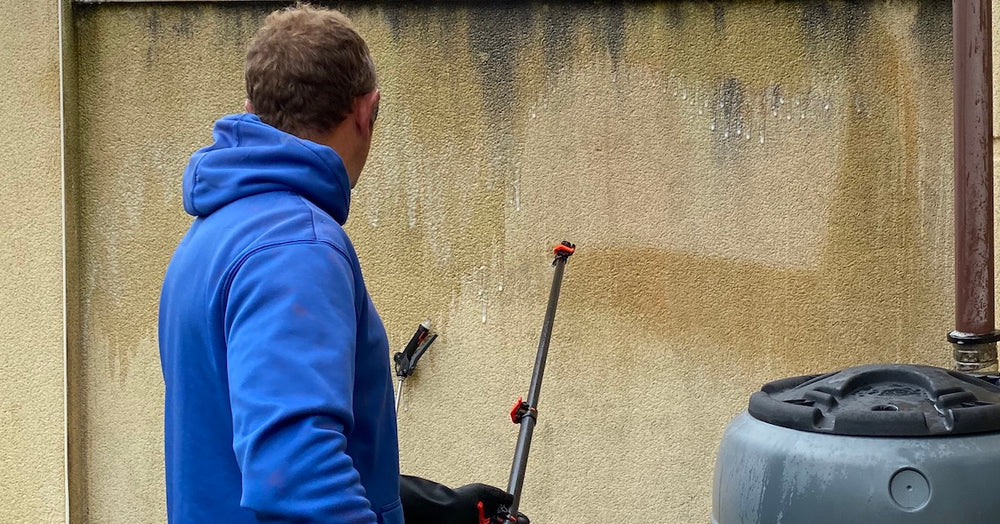
We've been asked, "Should I treat a property with Lightning Cleanze after treating with Bio Cleanze?"
Simple answer, most of the time, is No. Treat with Benz Lightning Cleanze first until the surface is sufficiently clean (treat particularly bad areas with Benz Tornado Cleanze), then complete the job with a treatment of Benz Bio Cleanze.
Why? Because the chemistry of the products means they work very differently. It just makes no sense to put Lightning Cleanze or Tornado Cleanze on top of Bio Cleanze.
Unless that is ... if absolutely essential because:
- A customer makes some idiosyncratic demand
- A mistake was made during application
- Some unforeseen circumstance arises
- You are softwashing sand and cement render
Quick tip: Even if Bio Cleanze is allowed to dry out before spot treating with Lightning Cleanze or Tornado Cleanze, this would involve another journey to the site – increasing time and travel overheads – and decreasing the profitability of the contract. Not good for business ...
The chemistry behind the principles
The strong possibility of the surfactant in Lightning Cleanze inhibiting the effectiveness of Bio Cleanze came from a conversation with a high-level industrial chemist. In other words, this is not just our opinion.
And is why it is so important to thoroughly rinse Lightning Cleanze from a surface prior to treating with Bio Cleanze.
And why we've never been happy with the procedure of "spot treating" with Lightning Cleanze after treating a surface with Bio Cleanze.
Chances are that no ill-effects will be seen for a while. But eventually the algae growth on the areas that were spot treated would likely be greater than the surrounding area.
Why?
Because the residual protection offered by Bio Cleanze will have been weakened by the spot treatment. The first application of Bio Cleanze will largely be dissipated by spraying, brushing, and then rinsing off Lightning Cleanze.
Only the chemical (DDAC) that had already managed to soak deep into the substrate will remain.
The reasons for treating with Bio Cleanze
The aim of treating a surface with Bio Cleanze is to kill any remaining spores that LIghtning Cleanze may have missed, especially those spores living deep in the substrate.
Because it is a highly effective "wetting agent" – due to it's chemical characteristics and capillary action made possible through low surface tension – Bio Cleanze can penetrate surfaces very deeply. Even more deeply than pure water. Click here to learn about capillary action
Bio Cleanze continues the cleaning process, begun by Lightning Cleanze, over several months and imparts a level of residual protection against re-colonisation.
Quick tip: The residual protective effect of Bio Cleanze can be less on horizontal surfaces that are subjected to:
- Heavy rainfall and pooling
- Hosing down by the customer
- Placement of plant pots on patios and paths
- Re-contamination by organic matter such as leaves and grass cuttings
A quick recap of the reasons for treating with Lightning Cleanze/Tornado Cleanze first and Bio Cleanze second
- Thoroughly rinsing Lightning Cleanze from a surface prior to treating with Bio Cleanze is important because rinsing will remove as much of the remaining surfactant as possible. If left, the surfactant can chemically react to, and inhibit the action of, Bio Cleanze.
- Rinsing Lightning Cleanze after treating with Bio Cleanze would simultaneously rinse off some of the previous treatment of Bio Cleanze, reducing it's ability to impart long-term residual protection from re-colonisation.
- Even if Bio Cleanze was left to soak into the substrate and dry for several days or weeks before treating with Lightning Cleanze, this would require another journey to the site, thus increasing time and travel overheads and thus reducing the profitability of the contract – and no softwash contractor wants to do that ...
Quick tip: After completing the first softwash treatment, put your customer on a "Clean & Maintain" ongoing maintenance programme.
Your customers will enjoy a permanently clean property and you will enjoy a steady stream of repeat business. A win-win arrangement for everyone.
We hope this information is helpful and sincerely wish you great success in your soft washing business,
Ben, Leo, Fiona, Stevie & Anthony



Leave a comment